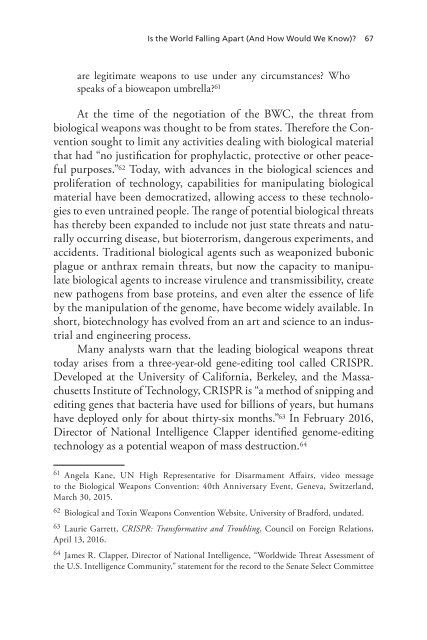You also want an ePaper? Increase the reach of your titles
YUMPU automatically turns print PDFs into web optimized ePapers that Google loves.
Is the World Falling Apart (And How Would We Know)? 67<br />
are legitimate weapons to use under any circumstances? Who<br />
speaks of a bioweapon umbrella? 61<br />
At the time of the negotiation of the BWC, the threat from<br />
biological weapons was thought to be from states. Therefore the Convention<br />
sought to limit any activities dealing with biological material<br />
that had “no justification for prophylactic, protective or other peaceful<br />
purposes.” 62 Today, with advances in the biological sciences and<br />
proliferation of technology, capabilities for manipulating biological<br />
material have been democratized, allowing access to these technologies<br />
to even untrained people. The range of potential biological threats<br />
has thereby been expanded to include not just state threats and naturally<br />
occurring disease, but bioterrorism, dangerous experiments, and<br />
accidents. Traditional biological agents such as weaponized bubonic<br />
plague or anthrax remain threats, but now the capacity to manipulate<br />
biological agents to increase virulence and transmissibility, create<br />
new pathogens from base proteins, and even alter the essence of life<br />
by the manipulation of the genome, have become widely available. In<br />
short, biotechnology has evolved from an art and science to an industrial<br />
and engineering process.<br />
Many analysts warn that the leading biological weapons threat<br />
today arises from a three-year-old gene-editing tool called CRISPR.<br />
Developed at the University of California, Berkeley, and the Massachusetts<br />
Institute of Technology, CRISPR is “a method of snipping and<br />
editing genes that bacteria have used for billions of years, but humans<br />
have deployed only for about thirty-six months.” 63 In February 2016,<br />
Director of National Intelligence Clapper identified genome-editing<br />
technology as a potential weapon of mass destruction. 64<br />
61 Angela Kane, UN High Representative for Disarmament Affairs, video message<br />
to the Biological Weapons Convention: 40th Anniversary Event, Geneva, Switzerland,<br />
March 30, 2015.<br />
62 Biological and Toxin Weapons Convention Website, University of Bradford, undated.<br />
63 Laurie Garrett, CRISPR: Transformative and Troubling, Council on Foreign Relations,<br />
April 13, 2016.<br />
64 James R. Clapper, Director of National Intelligence, “Worldwide Threat Assessment of<br />
the U.S. Intelligence Community,” statement for the record to the Senate Select Committee




